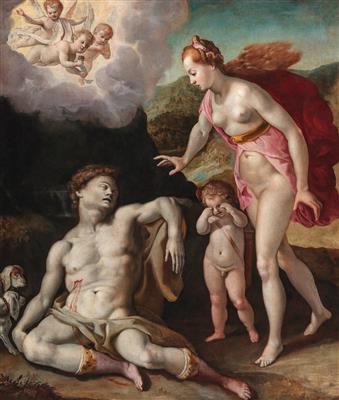Andrea Boscoli

(Florence circa 1584–1608 Rome)
Venus mourning the death of Adonis,
oil on canvas, 137 x 117 cm, framed
Provenance:
sale, Cambi Casa d’Aste, Genoa, 13 December 2019, lot 171 (as Emilian School, 17th Century);
where acquired by the present owner
Literature:
A. Nesi, C. Meoni, Andrea Boscoli. Confronti e note di stile, Florence 2020, p. 4, fig. 14 (as Attributed to Andrea Boscoli)
We are grateful to Nadia Bastogi for confirming the attribution and for her help in cataloguing the present painting.
Andrea Boscoli was a pupil of Santi di Tito and he was active in Medici Florence in the last decades of the sixteenth century, with sojourns in the Marche and Rome (see N. Bastogi, Andrea Boscoli, Florence, 2008).
The subject of this work derives from Ovid’s Metamorphoses (X, 520-559, 705-740) and follows the text written by Giovanni Andrea dell’Anguillara, published for the first time in Venice in 1561 and then in Florence in 1584 and 1592. Boscoli was interested in the representation of Ovidian tales, as is evidenced by numerous drawings and annotations in his account book and documentary sources. Among the known paintings of this type is the Piramo and Tisbe in the Uffizi, Florence (see fig. 1), datable to the late 1580s and documented from 1649 at the Medici Villa of Petraia. This work and the present canvas, both focus on the internal emotions of the grieving figures. The two compositions manifest the same Mannerist elegance, the same stylisation of the female body and the same accentuation of movement, seen here in the flowing hair, which are typical attributes of the painter.
Bastogi points out that the weeping putto in the present work is reminiscent of the work of Santi di Tito, as well as Gregorio Pagani, Agostino Ciampelli and Jacopo da Empoli. Adonis’s abandoned body in the present compostion returns to a similar design evident in other works by Boscoli. According to Bastogi, the putti at the top and the dogs next to Adonis’ body are not stylistically in line with the artist’s production, and these may be the work of an assistant.
Boscoli returned to the same subject in a drawing dated to 1608 which describes an earlier episode in the story (Gabinetto Disegni e Stampe degli Uffizi, Florence, 789 F). Bastogi dates the present work to the first half of the 1590s, after the Piramo and Tisbe. Alessandro Nesi, who independently gives this work to Boscoli, instead dates it earlier.
Esperto: Mark MacDonnell
 Mark MacDonnell
Mark MacDonnell
+43 1 515 60 403
old.masters@dorotheum.com
10.11.2020 - 16:00
- Stima:
-
EUR 40.000,- a EUR 60.000,-
Andrea Boscoli
(Florence circa 1584–1608 Rome)
Venus mourning the death of Adonis,
oil on canvas, 137 x 117 cm, framed
Provenance:
sale, Cambi Casa d’Aste, Genoa, 13 December 2019, lot 171 (as Emilian School, 17th Century);
where acquired by the present owner
Literature:
A. Nesi, C. Meoni, Andrea Boscoli. Confronti e note di stile, Florence 2020, p. 4, fig. 14 (as Attributed to Andrea Boscoli)
We are grateful to Nadia Bastogi for confirming the attribution and for her help in cataloguing the present painting.
Andrea Boscoli was a pupil of Santi di Tito and he was active in Medici Florence in the last decades of the sixteenth century, with sojourns in the Marche and Rome (see N. Bastogi, Andrea Boscoli, Florence, 2008).
The subject of this work derives from Ovid’s Metamorphoses (X, 520-559, 705-740) and follows the text written by Giovanni Andrea dell’Anguillara, published for the first time in Venice in 1561 and then in Florence in 1584 and 1592. Boscoli was interested in the representation of Ovidian tales, as is evidenced by numerous drawings and annotations in his account book and documentary sources. Among the known paintings of this type is the Piramo and Tisbe in the Uffizi, Florence (see fig. 1), datable to the late 1580s and documented from 1649 at the Medici Villa of Petraia. This work and the present canvas, both focus on the internal emotions of the grieving figures. The two compositions manifest the same Mannerist elegance, the same stylisation of the female body and the same accentuation of movement, seen here in the flowing hair, which are typical attributes of the painter.
Bastogi points out that the weeping putto in the present work is reminiscent of the work of Santi di Tito, as well as Gregorio Pagani, Agostino Ciampelli and Jacopo da Empoli. Adonis’s abandoned body in the present compostion returns to a similar design evident in other works by Boscoli. According to Bastogi, the putti at the top and the dogs next to Adonis’ body are not stylistically in line with the artist’s production, and these may be the work of an assistant.
Boscoli returned to the same subject in a drawing dated to 1608 which describes an earlier episode in the story (Gabinetto Disegni e Stampe degli Uffizi, Florence, 789 F). Bastogi dates the present work to the first half of the 1590s, after the Piramo and Tisbe. Alessandro Nesi, who independently gives this work to Boscoli, instead dates it earlier.
Esperto: Mark MacDonnell
 Mark MacDonnell
Mark MacDonnell
+43 1 515 60 403
old.masters@dorotheum.com
|
Hotline dell'acquirente
lun-ven: 10.00 - 17.00
old.masters@dorotheum.at +43 1 515 60 403 |
| Asta: | Dipinti antichi |
| Tipo d'asta: | Asta in sala con Live Bidding |
| Data: | 10.11.2020 - 16:00 |
| Luogo dell'asta: | Wien | Palais Dorotheum |
| Esposizione: | 04.11. - 10.11.2020 |
